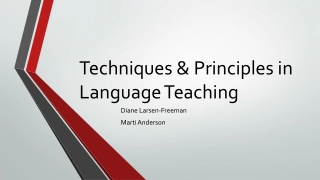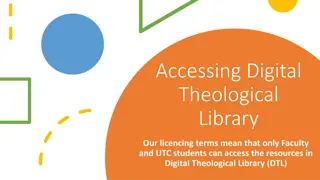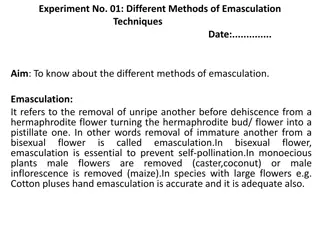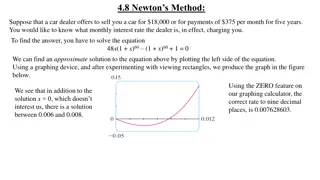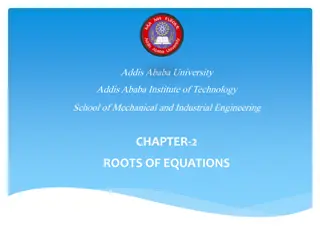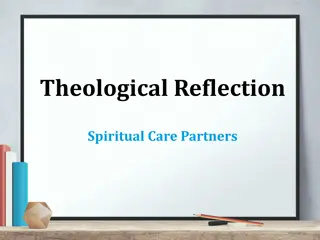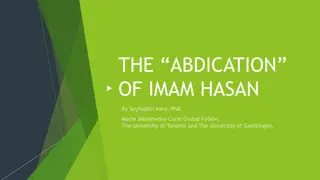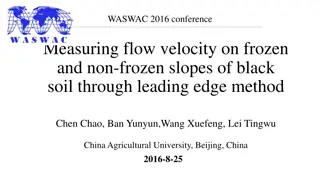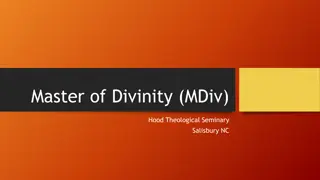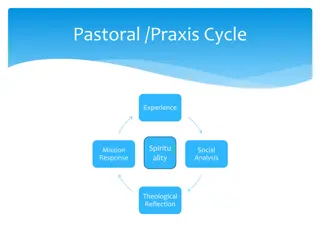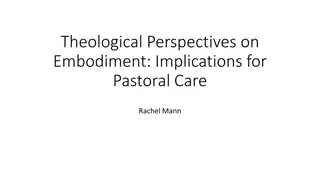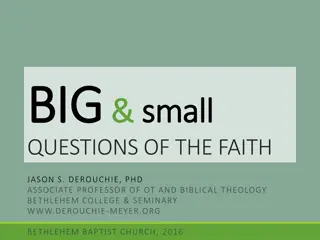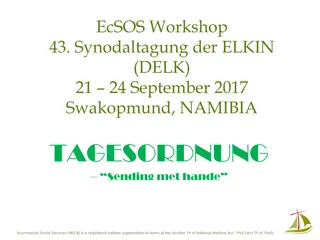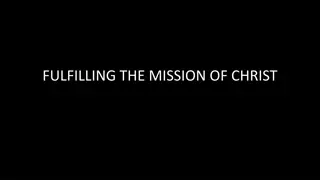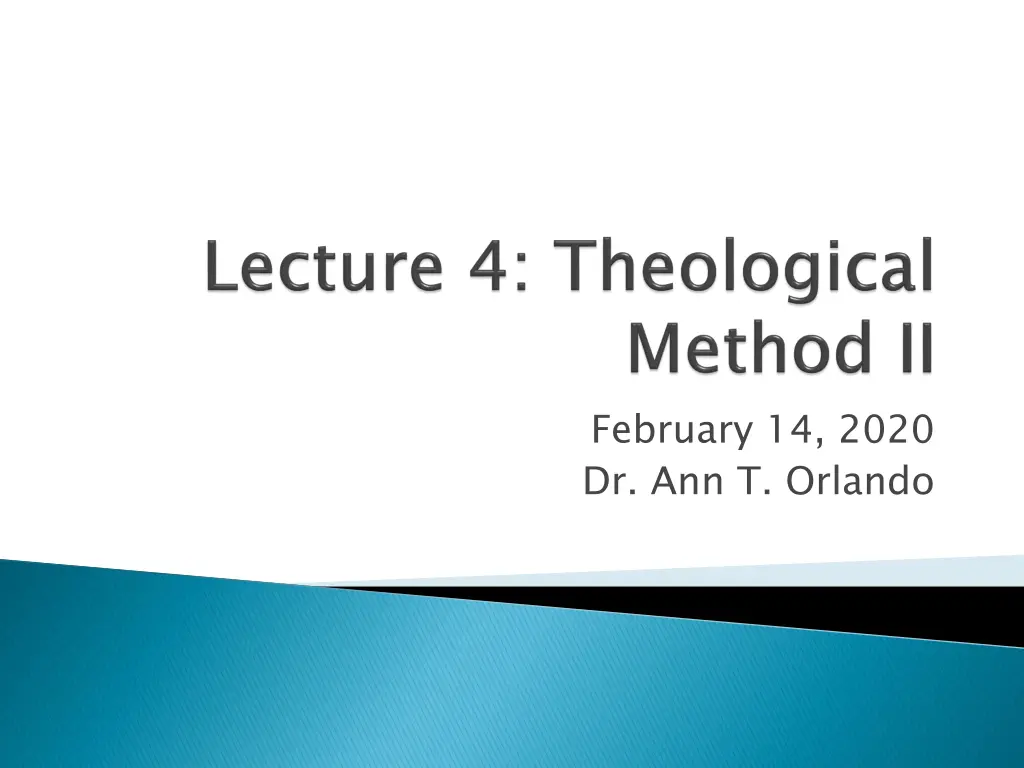
Approaching Language in Scripture: Interpretation and Allegory
Delve into Augustine's approach to interpreting the language of Scripture, distinguishing between literal and allegorical meanings. Explore the significance of Tychonius' views on the Church's composition, and the relation between the Old and New Testaments in conveying eternal truths.
Download Presentation

Please find below an Image/Link to download the presentation.
The content on the website is provided AS IS for your information and personal use only. It may not be sold, licensed, or shared on other websites without obtaining consent from the author. If you encounter any issues during the download, it is possible that the publisher has removed the file from their server.
You are allowed to download the files provided on this website for personal or commercial use, subject to the condition that they are used lawfully. All files are the property of their respective owners.
The content on the website is provided AS IS for your information and personal use only. It may not be sold, licensed, or shared on other websites without obtaining consent from the author.
E N D
Presentation Transcript
February 14, 2020 Dr. Ann T. Orlando
Outline of Books III and IV Sermon 179 Psalm 8 Contemporary Importance of De Doctrina Christiana
Books I and II focused on fundamentals of language and the relation of language to reality (things), Especially the language of Scripture and its relation to the ultimate reality, the Trinity Book III focuses on approaching the various meaning(s) of the language in Scripture (hermeneutics) Language (signs) in Scripture can have more than one meaning The arbiter of correct meanings is the Church
Recall that the Manichees reject the Old Testament because of a strictly literal interpretation Augustine asserts that all deeds of OT are to be interpreted figuratively (allegorically) as well as literally But need a method to properly use allegory Augustine inherits an allegorical tradition from Ambrose (who in turn inherits it from Origen, via the Cappadocians) Recall key moment in Confessions V.xiii-xiv when Augustine first hears Ambrose preach on an allegorical meaning of the Old Testament But Augustine does recognize that a figurative meaning cannot be unrestricted Rules are needed to guide proper interpretation
Tychonius, late 4thC, was a Donatist, but Also at odds with Donatists because he believed that the Church would remain mixed good and bad until the eschaton Also Augustine's view Only one of his works survives, The Book of Rules Likely because of its influence on Augustine, especially in DDC see Letter 249, To Restitutus
1 Scripture sometimes speaks of the Lord and the Church, i.e., His Body simultaneously 2 The Church in the world is mixed 3 God s eternal law is operative from the beginning of creation to its end 4 Scripture testifies to general truths using particular things, people of events 5 Particulars are not necessarily literal, but signify eternal truths 6 Relation between Old and New Testament is one of recapitulation 7 As with Rule 1, references to Satan may be to him specifically and/or his followers
How to know if an expression is proper or figurative: anything in the divine writings that cannot be referred either to good moral, honest morals or to the truth of the faith, you must know is said figuratively. (DCC III.x.14) Back to use and enjoy: By love I mean the impulse of one s mind to enjoy God on his own account and to enjoy oneself and one s neighbor on account of God; and by lust I mean the impulse of one s mind to enjoy oneself and one s neighbor and any corporeal thing not on account of God. (DDC III.x.16)
Signs can also be non-verbal; that is signs can be objects as signa translata: But the Lord himself and the discipline of the apostles has handed down to us a few signs and these so easy to perform, and so awesome to understand, and so pure and chaste to celebrate, such as the sacrament of baptism and the celebration of the Lord s body and blood. When people receive these they can recognize to what sublime realities they refer.
Sacraments are a movement from visible to invisible, from ordinary things (signs) to spiritual reality Sacraments as visible divine word Sacrament both sign and reality of the mystery (spiritual reality) of Christ Scripture as a sacrament Interpretation of Scripture as a Sacrament Creed and Lord s Prayer as Sacraments Triduum Church is the authority that mediates sacraments (including Scripture)
Augustine wrote Book IV 30 years after Book III As he says at the beginning of both Books I and IV, there are two things which every treatment of Scripture should strive for: A way of attaining an understanding of meaning (modus inveniendi) (i.e., discovery) A way of communicating what has been understood (modus proferendi) (IV.1.1, quoting I.1.1) The wisdom of what a person says is in direct proportion to his progress in learning the holy Scriptures and I am not speaking of intensive reading or memorization, but real understanding and careful investigation of their meaning. (IV.v.7)
Rhetoric can be used to convince people of falsehood; Christian preacher should first of all be concerned to preach the truth By reading and studying Christian literature outside of canon, preacher can learn how to preach. Before preaching, the preacher should lift his soul to God The benefit of preaching is effected by God Styles of preaching
Augustine used the Old Latin version of Scripture, based on LXX. Thus his numbering of Psalms at variance with usual English editions Written 392-418 Analysis of all 150 Psalms Key is understanding Psalms in the light of Christ and His Church Format is treatise and homiletic Because of their mixed style and purpose, Erasmus (16thC) referred to them as enarrationes For some Psalms, Augustine wrote more than one sermon or treatise. These are referenced as, for example, En. Ps 21 [1] En Ps 21 [2] English translation in WSA requires 6 volumes, making this one of Augustine s longest works
Totus Christus = the whole Christ, head and body, the Church When the members of the Church are united in love, they are acting as totus Christus One of the places Augustine meditates on totus Christus is in his study of the Psalms The bishop preaching and the congregation hearing are in that moment Church together meditating on the Psalms Listening to and praying with the voice of Christ
Prospological Or who is referred to in the biblical passage Go back to DDC and determine who is speaking; Christ or the Church or both (3.31.44) Just as there can be multiple meanings of Scripture, there can be multiple speakers of Scripture This is especially true for Augustine in his exegesis of the Psalms. Christ speaks the Psalms The Saints speak the Psalms The pilgrim Church speaks the Psalms All speak the Psalms at once together; thus as the totus See Exposition, Psalm 123.1 Prospological exegesis asks who is speaking Or who is referred to in the biblical passage Go back to DDC and Tyconius determine who is speaking; Christ or the Church or both (3.31.44) Just as there can be multiple meanings of Scripture, there can be multiple speakers of Scripture This is especially true for Augustine in his exegesis of the Psalms. Christ speaks the Psalms The Saints speak the Psalms The pilgrim Church speaks the Psalms All speak the Psalms at once together; thus as the totus Christus See Exposition, Psalm 123.1- -3 3 exegesis asks who is speaking Tyconius Rules; the first one is to Rules; the first one is to Christus
When we speak to God in prayer we do not separate the Son from God, and when the body of the Son prays it does not separate its head from itself. The one sole savior of his body is our Lord Jesus Christ, the Son of God, who prays for us, prays in us, and is prayed to by us. He prays for us as our priest, he prays in us as our head, and he is prayed to, by us, as our God. Accordingly we must recognize our voices in him, and his accents in ourselves ...We pray to him, through him and in him; we speak with him and he speaks with us.... Let no one, then, on hearing these words, maintain, 'This is not said by Christ', or, on the other hand, 'I am not speaking in this text'. Rather let each of us who know ourselves to be within Christ's body acknowledge both truths, that 'Christ speaks here', and that '1 speak here'. Say nothing apart from him, as he says nothing apart from you.
The Psalms are especially subject to variations Modifications for Extensive liturgical use Among the most frequently translated and distributed, and variations in language (Greek, Hebrew, Aramaic) In 2-3rdC hymns were also referred to as psalms, and often included parts of Psalms Jerome and the Vulgate In 4thC Jerome used Origen s Hexapla as the basis for a Latin psalter using the LXX version of the Psalms Later, Jerome worked on a different psalter using a Hebrew text In the Biblia Sacra Vulgate, the Psalms are given in two Latin versions, side-by-side based on Jerome s work using the LXX and the Hebrew By 5thC non-canonical reading or singing of hymns were forbidden during the liturgy Gave rise to the psalmodic movement of singing psalms in liturgy and monastic communities This movement extended to people singing psalms while working Take care to use Augustine s version (even if reconstructed) in reading his works on the Psalms
1 [For the end, concerning the wine-presses, a Psalm of David.] 2 O Lord, our Lord, how wonderful is thy name in all the earth! for thy magnificence is exalted above the heavens. 3 Out of the mouth of babes and sucklings hast thou perfected praise, because of thine enemies; that thou mightest put down the enemy and avenger. 4 For I will regard the heavens, the work of thy fingers; the moon and stars, which thou hast established. 5 What is man, that thou art mindful of him? or the son of man, that thou visitest him? 6 Thou madest him a little less than angels, thou hast crowned him with glory and honour; 7 and thou hast set him over the works of thy hands: thou hast put all things under his feet: 8 sheep and all oxen, yea and the cattle of the field; 9 the birds of the sky, and the fish of the sea, the [creatures] passing through the paths of the sea. 10 O Lord our Lord, how wonderful is thy name in all the earth! For the leader; upon the gittith. * *A psalm of David. 2 2O LORD, our Lord, how awesome is your name through all the earth! I will sing of your majesty above the heavens 3 3with the mouths of babesa aand infants.* * You have established a bulwark* *against your foes, to silence enemy and avenger.* * 4 4When I see your heavens, the work of your fingers, the moon and stars that you set in place 5 5* *What is man that you are mindful of him,b b and a son of man that you care for him?c c 6 6Yet you have made him little less than a god,* * crowned him with glory and honor. 7 7You have given him rule over the works of your hands,d d put all things at his feet: 8 8All sheep and oxen, even the beasts of the field, 9 9The birds of the air, the fish of the sea, and whatever swims the paths of the seas. 10 how awesome is your name through all the earth! 10O LORD, our Lord, LXX Breton Translation NAB
Augustine is using a Latin Version of the LXX Note the importance placed by Augustine on the inscription (first verse) which differs between LXX and MT The exposition of Psalm 8 is entirely allegorical, with multiple levels of allegory But the key is Jesus Christ and the Church
Perhaps given in Thagaste, Augustines home town where Alypius was bishop Also where he had family and longstanding friends Back to Mary and Martha The emphasis is on the dangers of pride for the preacher In 179.3 Augustine discusses standing and sitting Standing was a sign of perseverance in one s duty Sitting (prostrate) a sign of humility in the presence of an authority While the congregation is listening, they should also be praying for the preacher The end of the homily is likely lost
Born in Vienna in 1889 Moved to Cambridge in 1911 and developed close relation with Bertrand Russell Returned to Austria and fought in WW I POW After WWI settled permanently in Cambridge Died in 1951
The only problem in philosophy is language Tractatus Logico-Philosophicus was first published in German in 1921, shortly after in English Thought is more like a picture than language Language used to describe thoughts Opposed to Augustine s theory of language as signs Philosophical Investigations was published posthumously in 1953 (translated and edited by G.E.M. Anscombe) A type of reconsideration of earlier work Begins with Augustine and language, with a quote from Conf. I.8.13 A reconsideration of Augustine s sign model of language Develops language-game as a way to describe language; but rules of game are not static
Student of Heidegger Most important work, Truth and Method Opposed to notion that scientific method can be applied to human sciences, especially history, philosophy and literature Human sciences rooted in language (not mathematics) Understand the human sciences in terms of culture and education: hermeneutical circle Culture and education now shaped by preceding culture and education (history) gives people in society necessary pre- understanding Classic: we approach a classic with the cultural judgment that the text has authority The effect of a classic in subsequent generations Application of the text to current circumstance
Jurgen Habermas (b. 1929) Famously in dialog with Joseph Ratzinger Endurance of classics may not be because of enduring value, but because reinforce power structures Texts can distort understanding Example: Augustine and Donatists Jacques Derrida (1930 2004) Language changes; each person creates own meaning from language Questions ability to find common truth across history and peoples Deconstruction Key work, Circumfessions
German, Jewish, philosopher Barely escapes Nazis and immigrates to US Most famous work is based on her dissertation, an analysis of DCC and other of Augustine s works Published in English in 1996 as Hannah Arendt. Love and Saint Augustine. Among other things argues that Augustine's notion of use of others to attain God is ultimately destructive of society See Rowan Williams rebuttal of Arendt in Language, Reality and Desire in Augustine s De Doctrina Arendt very influenced by CoG and the libido domeniandi in her Origins of Totalitarianism But likely she is most famous for referring to Adolph Eichmann and Nazi holocaust as the banality of evil. She was a correspondent for The New Yorker at Eichmann s trial and subsequently wrote a book about it, Eichmann in Jerusalem. Based on her reading of Augustine and evil as privation
DDC Books III and IV Sermon 179 Exposition Psalm 8 Prepare paper #4
Salon, Peter. Augustines Theology of Preaching. Lanham: Fortress, 2014. Schildgen, Brenda Dean. Augustine s Answer to Jacques Derrida in the De Doctrina Christiana, New Literary History, Vol. 25, No. 2., Writers on Writers (Spring 1994), pp. 383-397. Andrews, James. Why Theological Hermeneutics Needs Rhetoric: Augustine s De doctrina Christiana, International Journal of Systematic Theology Vo. 12 No. 2 April 2010; pp 184-200. Arendt, Hannah. Love and Saint Augustine. Chicago: University of Chicago Press, 2014.

